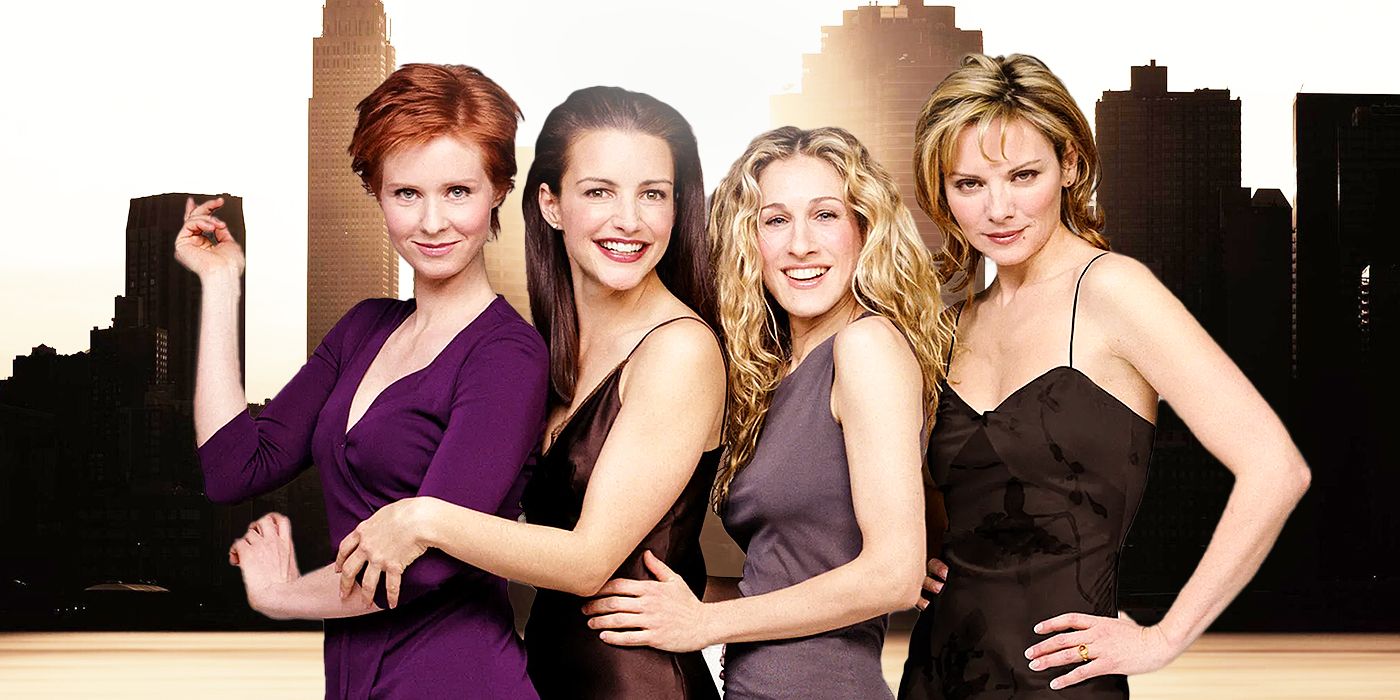Few television series have left as indelible a mark on popular culture as "Sex and the City." From its groundbreaking portrayal of female sexuality to its unapologetic celebration of friendship, this HBO phenomenon captivated audiences worldwide. It wasn't just a show; it was a cultural touchstone that sparked conversations, challenged norms, and offered a candid glimpse into the lives of four distinct New York women navigating the complexities of love, lust, and career in the late 1990s and early 2000s.
At its core, "Sex and the City" dared to speak openly about topics often relegated to hushed whispers, bringing the intimate details of women's sex lives and romantic entanglements into the mainstream. With its sharp wit, fashionable flair, and deeply relatable characters, the series became an instant classic, influencing everything from fashion trends to the way we discuss modern relationships. Its impact continues to resonate, making it a subject of fascination and study for fans and cultural critics alike.
Table of Contents:
- Who Is The Next Bachelorette 2024
- 2023 Masters Winner
- How Did Bernie Mac Die
- Tallulah Willis
- Nikki Catsouras Photos
- The Dawn of a Cultural Phenomenon: Sex and the City's Genesis
- From Page to Screen: Candace Bushnell's Vision
- The Quintessential Four: Carrie, Samantha, Miranda, and Charlotte
- The Power of Female Friendship and Open Dialogue
- Navigating Love, Lust, and Life in New York City
- Beyond the Bedroom: Sex and the City's Broader Societal Impact
- Redefining Sexual Health Conversations
- The Show's Enduring Legacy and Evolution
- Behind the Scenes: Cast, Controversies, and Continuations
- The Chris Noth Allegations: A Sobering Reality Check
- The Unforgettable Episodes and Moments
- The Enduring Allure of Sex and the City
The Dawn of a Cultural Phenomenon: Sex and the City's Genesis
"Sex and the City" burst onto the scene as an American cable television program, originally broadcast on the HBO network from 1998 until 2004. Over its six seasons, it delivered a total of ninety-four episodes, each one a window into the lives of four female New Yorkers. The show quickly became one of the most popular and influential TV series of the late 1990s and early 2000s, carving out a unique space in the television landscape.
What set it apart was its unapologetic focus on women's experiences, particularly their sex lives (or lack thereof), and their ongoing quest to navigate the complexities of being a woman in a rapidly changing world. The series offered a fresh, often humorous, and surprisingly poignant look at relationships, career, and identity through the lens of its unforgettable protagonists. The official website for "Sex and the City" on HBO, alongside platforms like Moviefone, provided fans with a wealth of content, from interviews and schedule information to behind-the-scenes exclusives, highlighting the show's significant online presence even in its early days.
From Page to Screen: Candace Bushnell's Vision
The genesis of "Sex and the City" lies in the book of the same name by Candace Bushnell. Bushnell's columns, which later formed the basis of her book, offered a sharp, observational, and often humorous look at the dating scene in New York City. Her work resonated with many, providing a candid and often raw perspective on modern romance. The adaptation to television by HBO, known for its cutting-edge and often provocative programming, was a natural fit.
The show successfully translated Bushnell's witty observations into a vibrant, visual narrative, allowing audiences to discover the show's synopsis, cast details, and season information with ease. It wasn't just about translating words; it was about bringing the spirit of the columns to life, creating characters that felt real and relatable, even in their most outlandish moments. This successful transition from print to screen laid the groundwork for the show's monumental success.
The Quintessential Four: Carrie, Samantha, Miranda, and Charlotte
At the heart of "Sex and the City" were its four central characters, each brought to life by a talented ensemble cast: Sarah Jessica Parker as Carrie Bradshaw, Kim Cattrall as Samantha Jones, Kristin Davis as Charlotte York, and Cynthia Nixon as Miranda Hobbes. These four women, distinct in their personalities, careers, and approaches to life and love, formed the core of the show's narrative.
Sarah Jessica Parker, starring in HBO's hit series, embodied Carrie Bradshaw, a thirtysomething writer whose life and friendships became fodder for her weekly column, "Sex and the City." Carrie's voice-overs, often musing on the intricacies of relationships and societal norms, served as the narrative backbone of the show. Her journey, alongside her best friends Miranda, Charlotte, and Samantha, provided a multifaceted exploration of what it meant to be a woman in New York City at the turn of the millennium.
The Power of Female Friendship and Open Dialogue
While the show's title explicitly highlights "sex," the true enduring power of "Sex and the City" lay in its celebration of female friendship. These four women consistently turned to each other for advice, solace, and laughter as they experienced love and lust in New York City. Their brunches, phone calls, and late-night confessions became iconic, demonstrating a bond that transcended their individual romantic pursuits.
In the pilot episode of this hit comedy series, Carrie and her friends famously vow to start having sex like men, a bold declaration that set the tone for the show's candid approach to sexuality. This wasn't just about casual encounters; it was about reclaiming agency, exploring desires, and challenging traditional gender roles in relationships. The show normalized open conversations about sex, dating, and the challenges women faced, making it a groundbreaking series for its time. Their gossip sessions about their sex lives (or lack thereof) were not merely superficial; they were a vital mechanism for processing their experiences and finding new ways to deal with being a woman in the late 1990s.
Navigating Love, Lust, and Life in New York City
"Sex and the City" offered a vivid portrayal of life in New York City, a character in itself within the series. The city's vibrant energy, its endless possibilities, and its unique challenges provided the backdrop for the women's personal and professional journeys. From upscale restaurants to gritty downtown bars, the show painted a picture of a metropolis where anything seemed possible, especially in matters of the heart.
The series delved into a wide array of relationship dynamics, from fleeting flings to long-term commitments, from the pursuit of "the one" to the realization that self-love might be the most important relationship of all. Carrie's tumultuous on-again, off-again relationship with Mr. Big became a central romantic arc, a testament to the complexities and often frustrating realities of modern love. Each character's journey with love and lust was unique, reflecting different facets of the female experience: Miranda's pragmatic approach, Charlotte's romantic idealism, Samantha's uninhibited sexual liberation, and Carrie's perpetual quest for answers in her column.
Beyond the Bedroom: Sex and the City's Broader Societal Impact
While often celebrated for its fashion and frank discussions of sex, "Sex and the City" also had a profound, albeit often understated, impact on broader societal conversations. It challenged the prevailing narratives around single women, demonstrating that a fulfilling life could exist outside of traditional marriage and motherhood. The show implicitly, and sometimes explicitly, touched upon themes of independence, career ambition, and the evolving roles of women in society.
The series provided a platform for exploring various aspects of modern life, including the nuances of gender and identity. Gender, as the show subtly demonstrated through its diverse characters and their experiences, is related to but different from gender identity. Gender identity refers to a person’s deeply felt, internal and individual experience of gender, which may or may not correspond to the person’s physiology or designated sex at birth. This distinction, while not explicitly detailed in the show, was implicitly explored through the varied expressions of womanhood and sexuality presented. The show's influence extended beyond entertainment, subtly shaping public discourse around personal autonomy and lifestyle choices.
Redefining Sexual Health Conversations
One of the less obvious but equally significant impacts of "Sex and the City" was its contribution to normalizing conversations around sexual health. By openly depicting characters' sexual encounters and their consequences, the show inadvertently highlighted the importance of understanding risks. While primarily entertainment, the show's frankness could prompt viewers to consider their own knowledge about the risks they may face and their vulnerability to adverse consequences of unprotected sexual activity.
In a broader context, the discussions around sex in the series, however fictionalized, align with the modern understanding of sexual health. Sexual health is not merely the absence of disease, dysfunction, or infirmity. It requires a positive and respectful approach to sexuality and sexual relationships, as well as the possibility of having pleasurable and safe sexual experiences, free of coercion, discrimination, and violence. The show, through its characters' trials and tribulations, often underscored the need for individuals to have the ability to access sexual health care and to live in an environment that affirms and promotes sexual health.
For instance, discussions around various sexual health topics, though not clinical, resonated with real-world health considerations. The provided data highlights specific medical contexts, such as abstaining from sex during certain treatments. For example, abstaining from sex during treatment for vaginal infections gives the vaginal flora time to return to normal. Similarly, it is recommended to avoid exposing a sexual partner to vaginal estrogen cream by not having sex right after application, as a partner may absorb estrogen through his penis, requiring planning to insert cream after intercourse instead. These are practical considerations that, while not explicitly part of the show's narrative, are relevant to the broader theme of sexual health that the show helped bring into the open.
Furthermore, the show's frankness, even if fictional, aligns with research that recommends redesigning sexual education and health interventions to incorporate sexual pleasure considerations, including when promoting safer sex. While "Sex and the City" was not a health education program, its willingness to portray diverse sexual experiences could contribute to a more holistic view of sexuality in popular culture. It also implicitly touches upon how gender influences people’s experience of and access to healthcare, as the women often discussed their health concerns and sought advice, reflecting real-world disparities and needs.
Even specific medical conditions, like erectile dysfunction, are implicitly part of the broader sexual landscape the show touched upon. Sildenafil (Viagra brand), for example, is used to treat erectile dysfunction and pulmonary arterial hypertension. It increases blood flow to the penis following sexual stimulation by blocking the enzyme responsible for the breakdown of cGMP, a substance that relaxes and widens blood vessels and smooth muscle cells, allowing men to keep an erection hard enough for sex. While the show didn't delve into the pharmacology of such medications, its portrayal of various male partners and their struggles (or successes) in the bedroom opened up a space where such topics could be discussed more openly in society.
The Show's Enduring Legacy and Evolution
"Sex and the City" concluded its original run on HBO in 2004, but its influence hardly waned. The series continued to be a cultural touchstone, spawning two feature films, "Sex and the City" (2008) and "Sex and the City 2" (2010), which allowed fans to revisit their beloved characters and see how their lives had evolved. These films, while met with mixed critical reception, proved the enduring popularity of the franchise.
The show's legacy extends beyond its direct sequels. It paved the way for numerous other series that explored female friendships, urban living, and modern relationships with a similar candidness. Its fashion influence remains unparalleled, with Carrie Bradshaw's iconic style inspiring countless trends and solidifying Sarah Jessica Parker's status as a fashion icon. The show's portrayal of New York City also boosted tourism, with fans eager to visit the real-life locations frequented by Carrie and her friends.
Behind the Scenes: Cast, Controversies, and Continuations
The success of "Sex and the City" brought immense fame to its principal cast members. Sarah Jessica Parker, Kim Cattrall, Kristin Davis, and Cynthia Nixon became household names, forever associated with their iconic roles. After "Sex and the City," Parker and her husband, Matthew Broderick, welcomed twin daughters in 2009, adding to their family which also includes a son. The lives of the actors, much like their characters, continued to evolve in the public eye.
The show's journey, however, was not without its challenges and controversies. Speculation about a rift between Sarah Jessica Parker and Kim Cattrall, who played Samantha Jones, often made headlines, contributing to Cattrall's decision not to return for later iterations of the franchise. This dynamic highlighted the complexities of long-running television productions and the relationships between cast members.
The Chris Noth Allegations: A Sobering Reality Check
A more serious controversy emerged shortly after Chris Noth's "Sex and the City" character, Mr. Big, died onscreen in December 2021 in the sequel series "And Just Like That..." Noth was accused of sexual assault by multiple women, which he denies. This development cast a shadow over the beloved character and the show's legacy, prompting difficult conversations among fans and critics alike. It served as a stark reminder that the entertainment industry, like any other, is not immune to serious allegations, and that the actions of individuals can profoundly impact the perception of their work. This incident underscores the importance of separating art from artist, while also acknowledging the very real and serious nature of such accusations.
The Unforgettable Episodes and Moments
"Sex and the City" is replete with memorable episodes and iconic moments that have been etched into the minds of its viewers. From Carrie's philosophical musings typed on her laptop to Samantha's unapologetic pursuit of pleasure, each episode offered a blend of humor, drama, and relatable human experience. The show's ability to tackle sensitive topics with both wit and sensitivity was a hallmark of its writing.
Whether it was the pilot episode where Carrie and her friends vow to start having sex like men, or the emotional series finale that brought closure (for a time) to Carrie's relationship with Mr. Big, the show consistently delivered compelling narratives. Fans could watch trailers, exclusive interviews, and episode reviews through platforms like Moviefone and HBO's official site, diving deeper into the show's rich content. These moments, often discussed and re-watched, cemented the series' place in television history.
The Enduring Allure of Sex and the City
More than two decades after its premiere, the allure of "Sex and the City" remains strong. It continues to be discovered by new generations of viewers, who can watch "Sex and the City" and other popular TV shows and movies, including new releases, classics, Hulu Originals, and more, on various streaming platforms. The themes it explored—friendship, love, sex, career, and self-discovery—are timeless and universal, ensuring its continued relevance.
The show's impact on fashion, its candid discussions about female sexuality, and its celebration of urban life have left an undeniable legacy. It proved that a show centered on women's experiences could be both critically acclaimed and wildly popular. "Sex and the City" wasn't just entertainment; it was a cultural phenomenon that dared to ask bold questions and offered a vibrant, often hilarious, look at what it means to be a modern woman. Its influence continues to shape how we talk about relationships, identity, and the pursuit of happiness in the bustling heart of New York City.
In conclusion, "Sex and the City" transcended its initial premise to become a powerful cultural force. It championed female friendships, revolutionized discussions about sex and relationships, and inspired countless viewers with its blend of humor, heart, and high fashion. While aspects of the show and its associated controversies have invited re-evaluation, its core message of female empowerment and the enduring strength of sisterhood remains a resonant part of its legacy.
What are your most unforgettable moments from "Sex and the City"? Share your thoughts in the comments below, or explore more articles on our site about iconic TV shows and their cultural impact!


